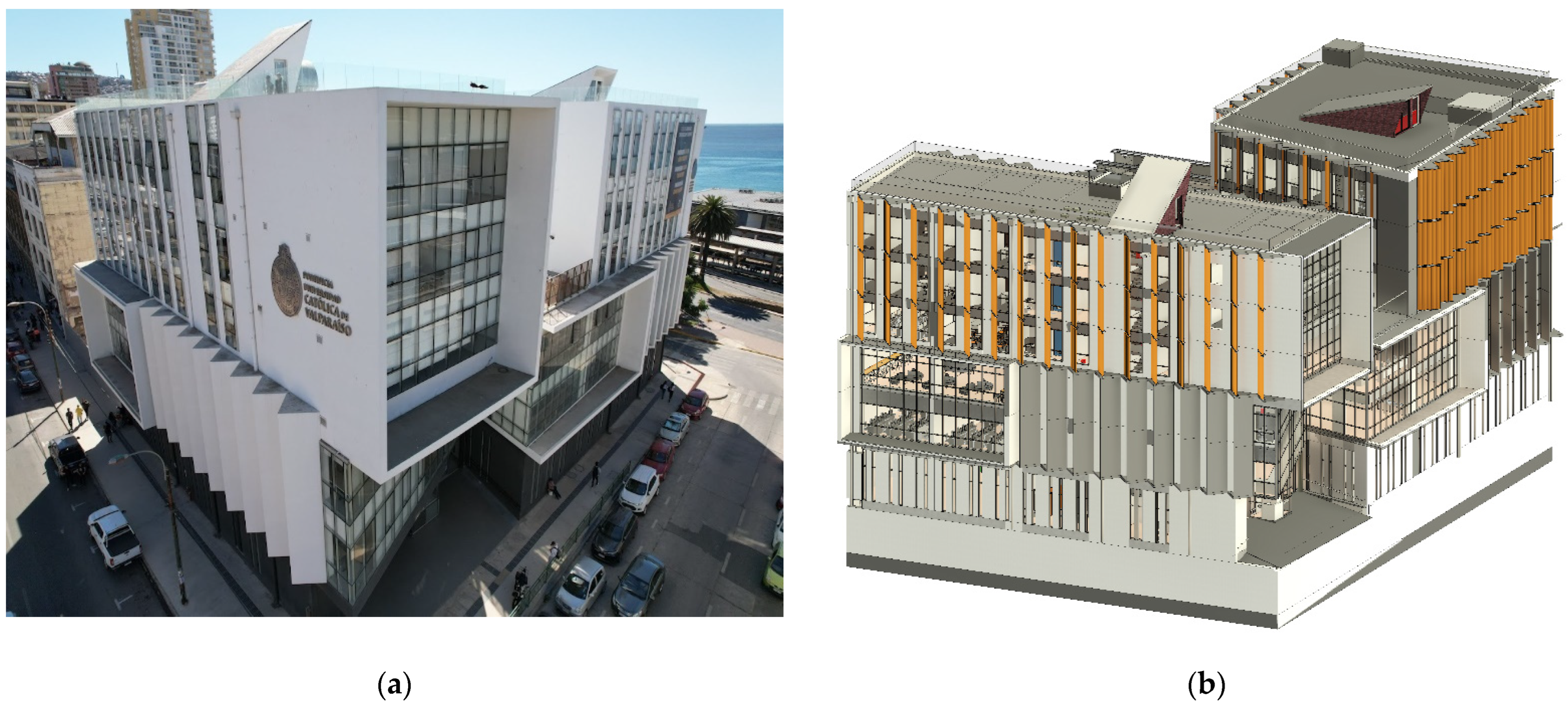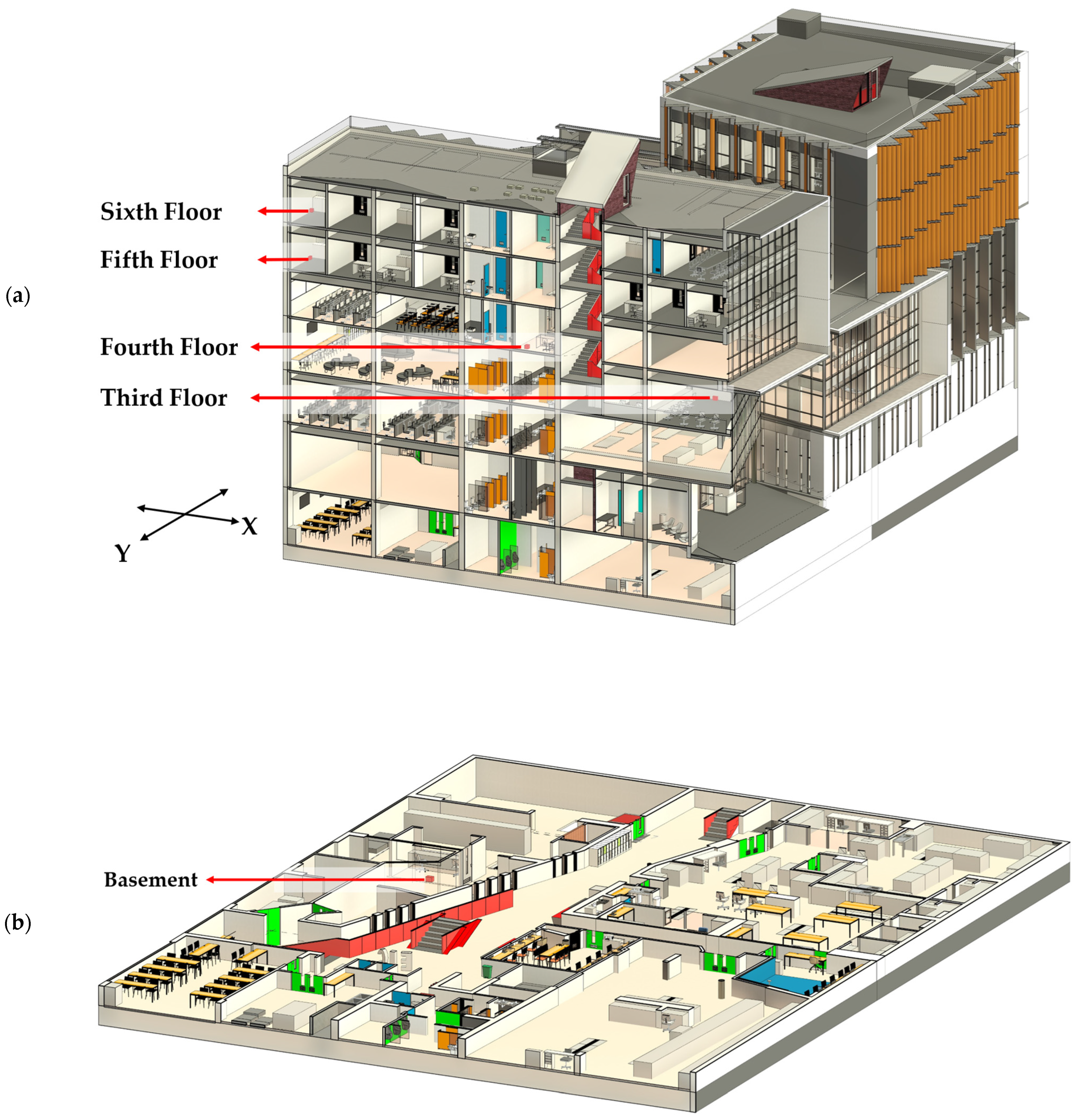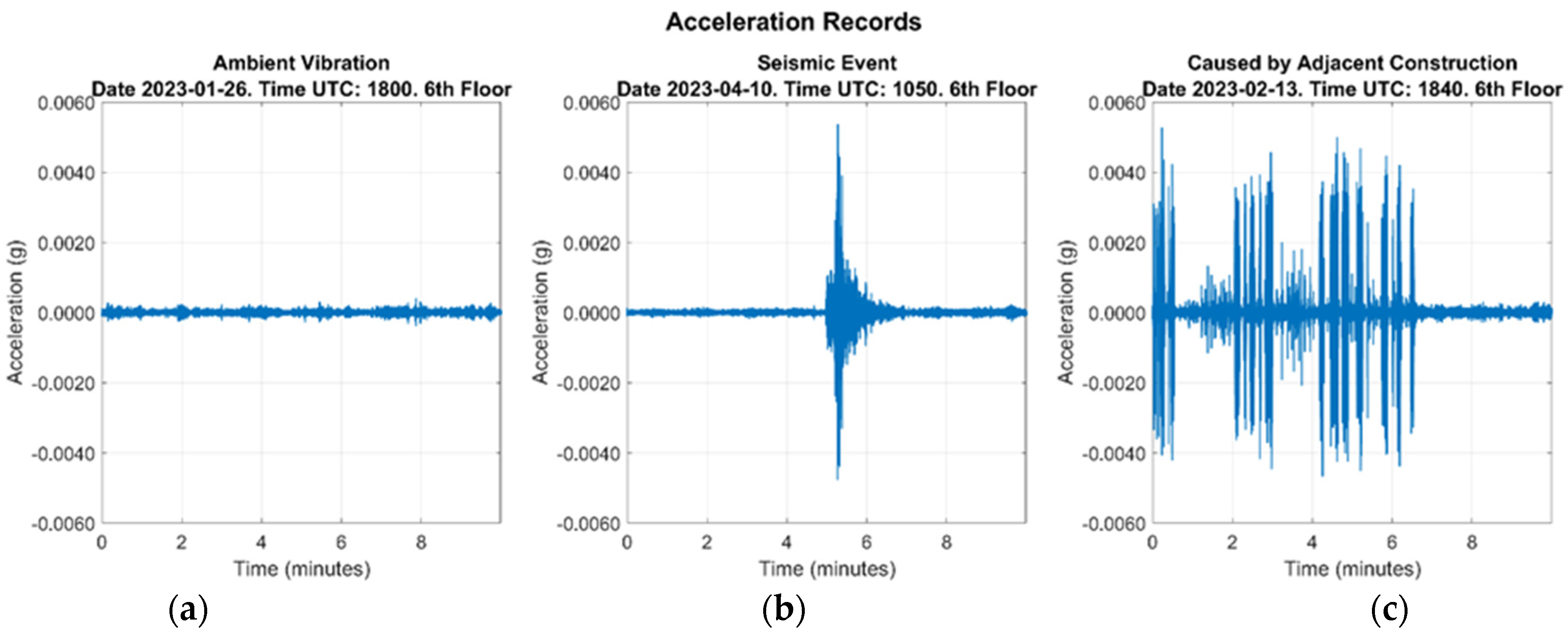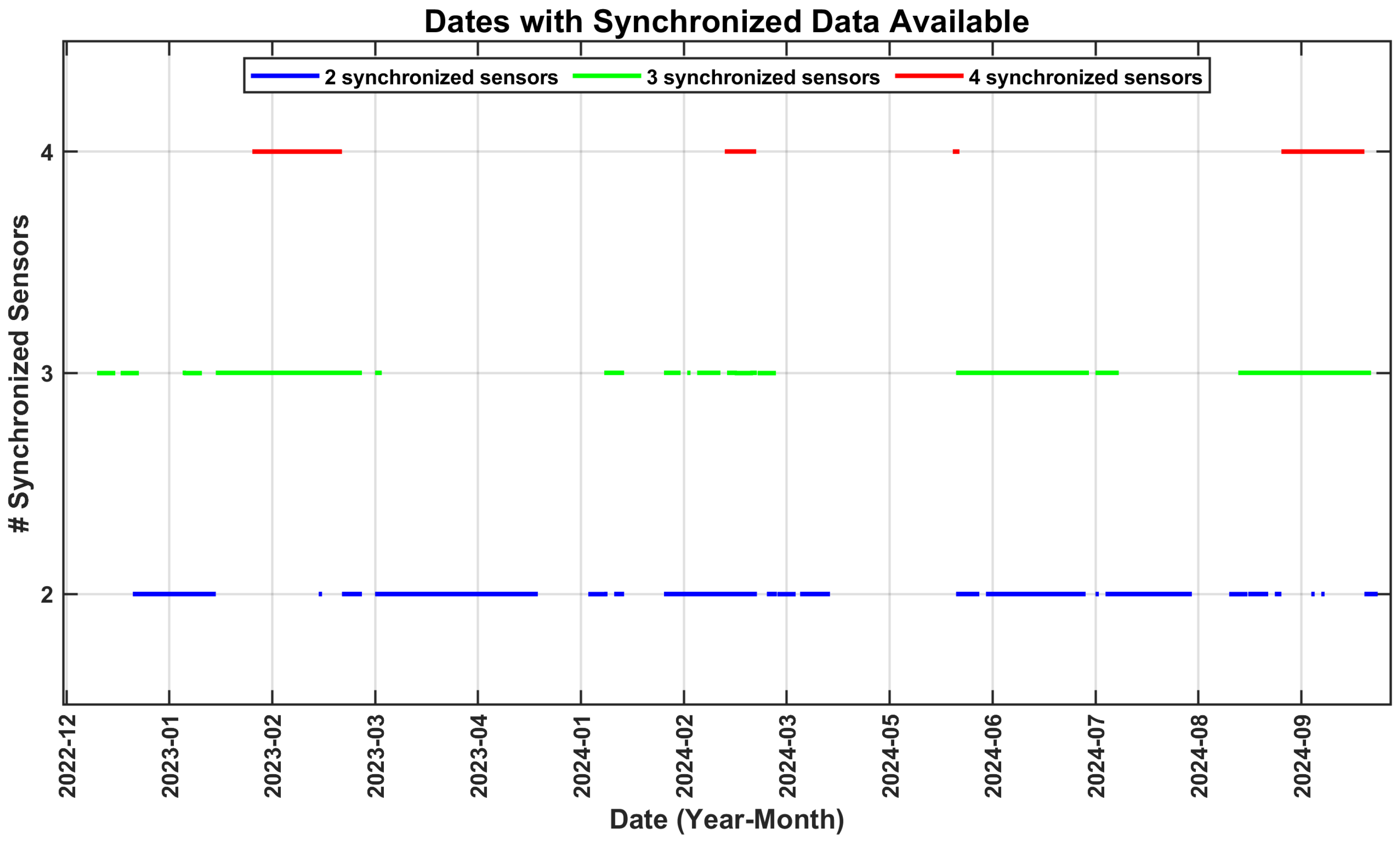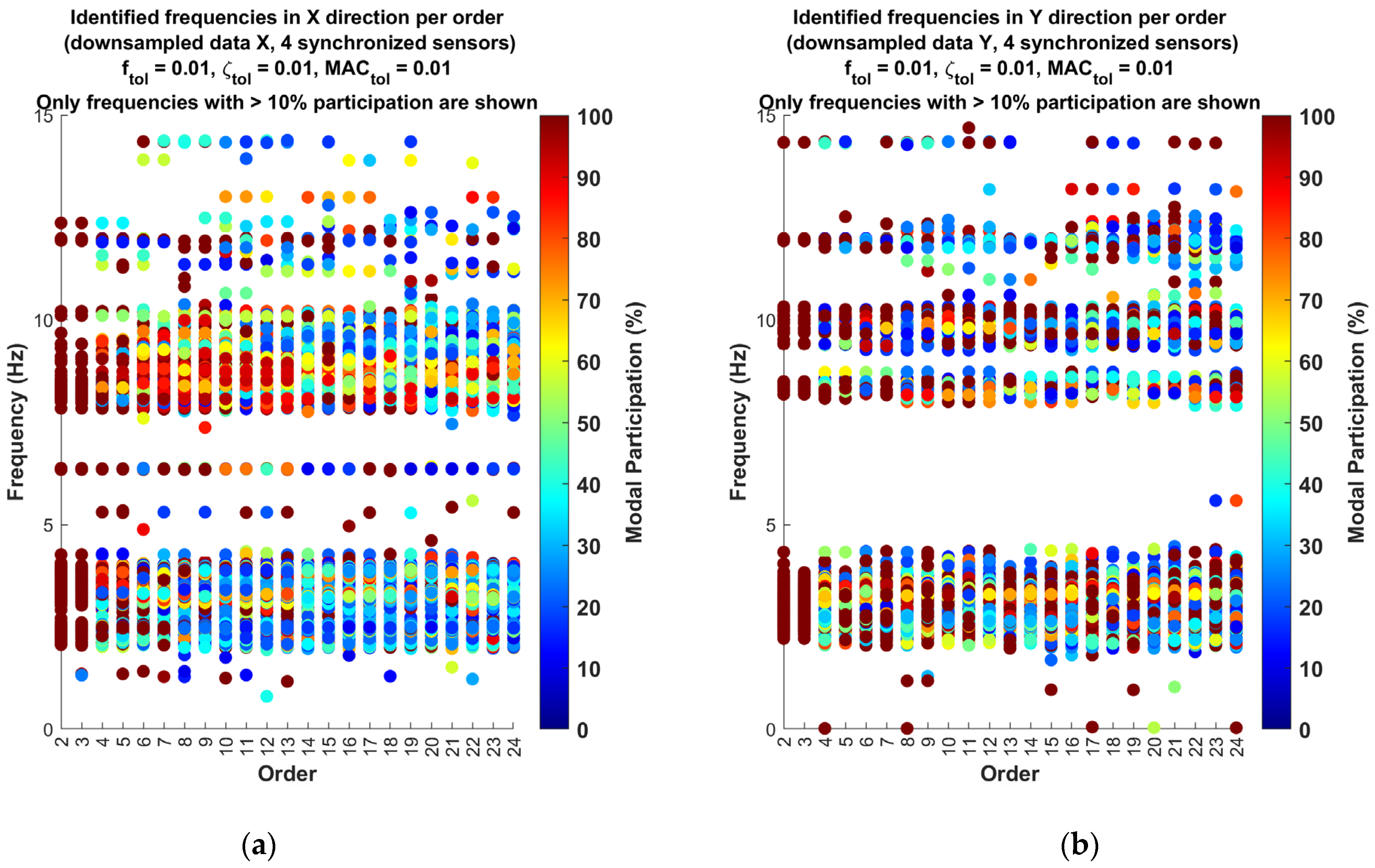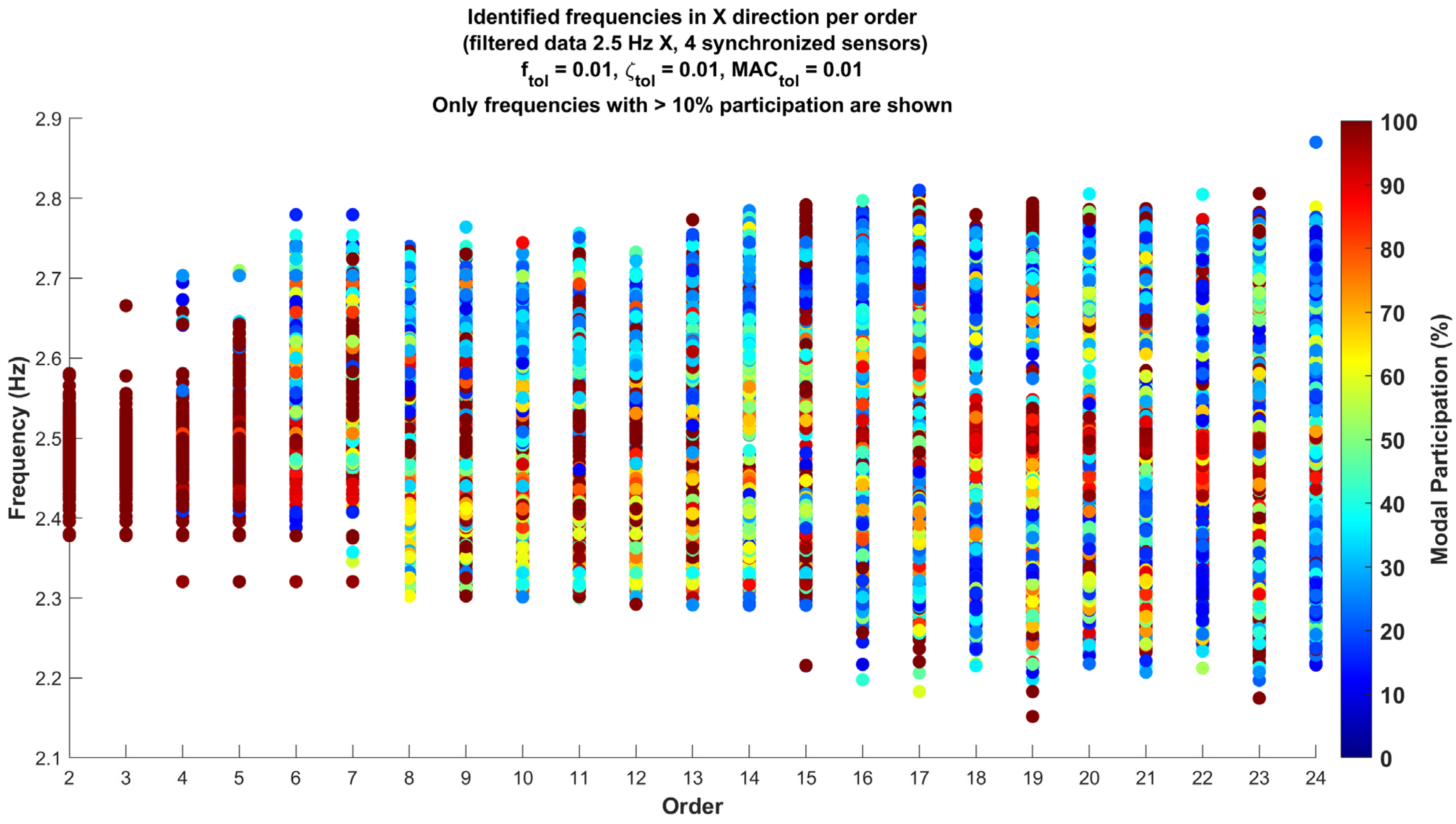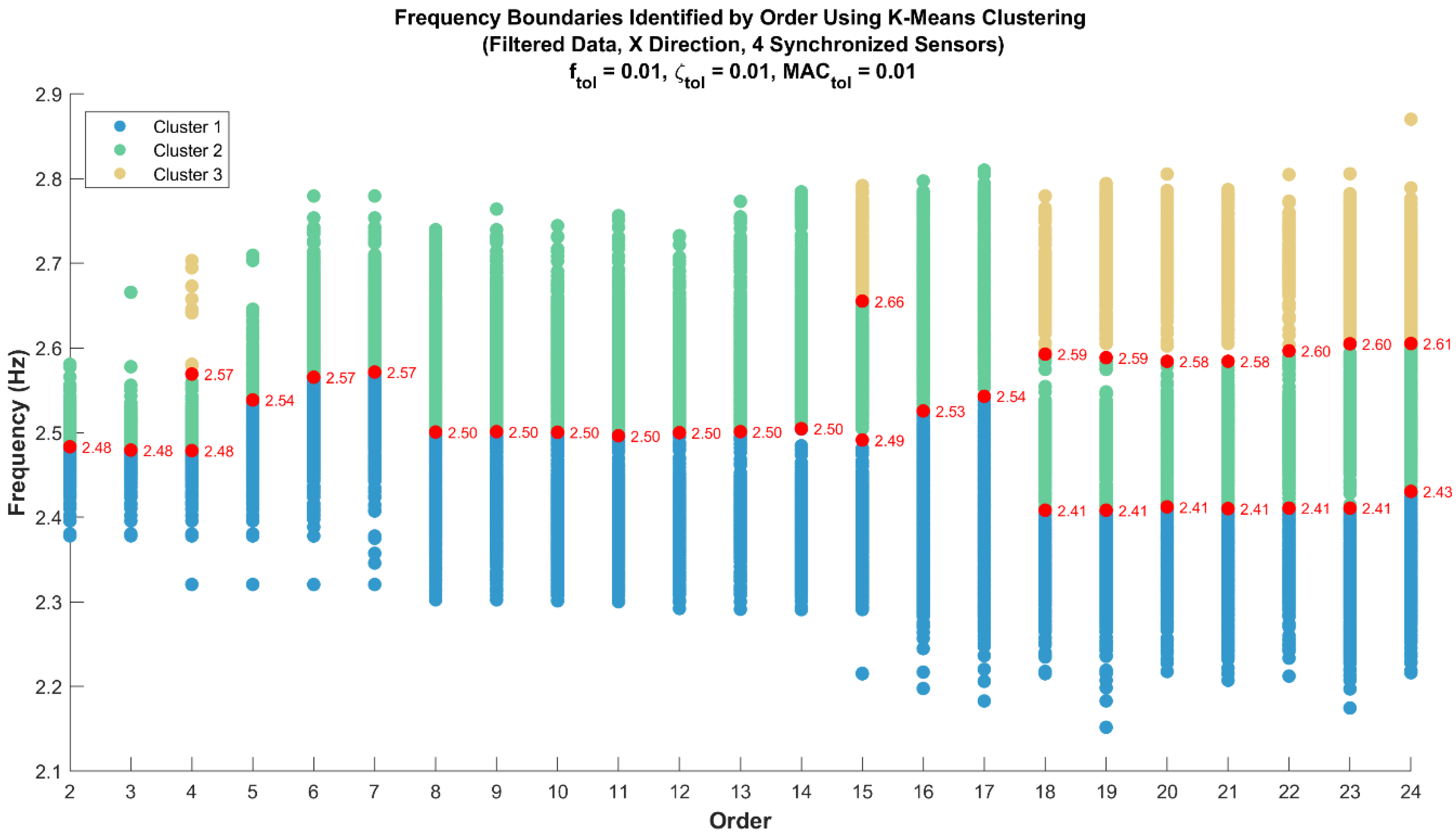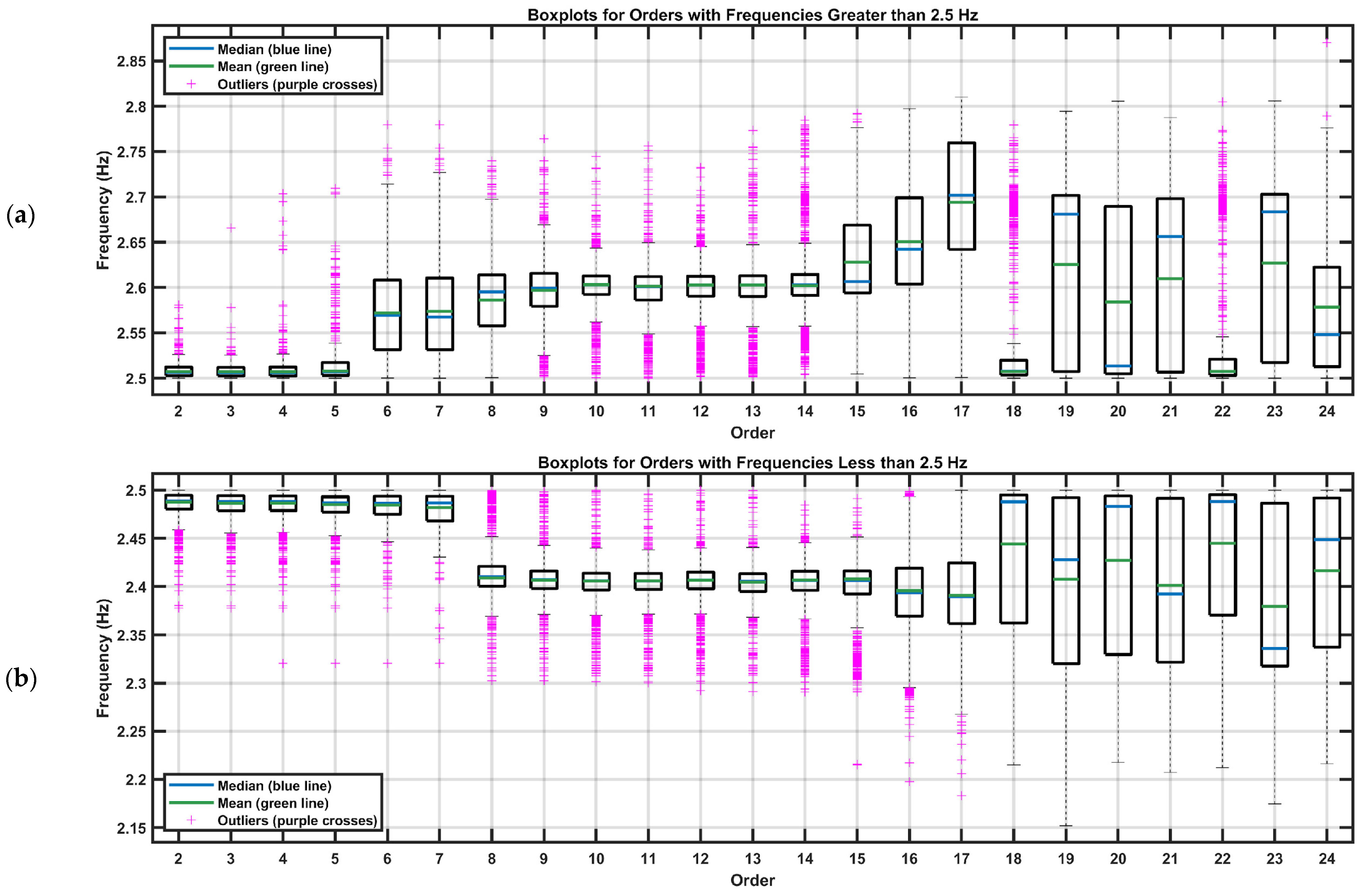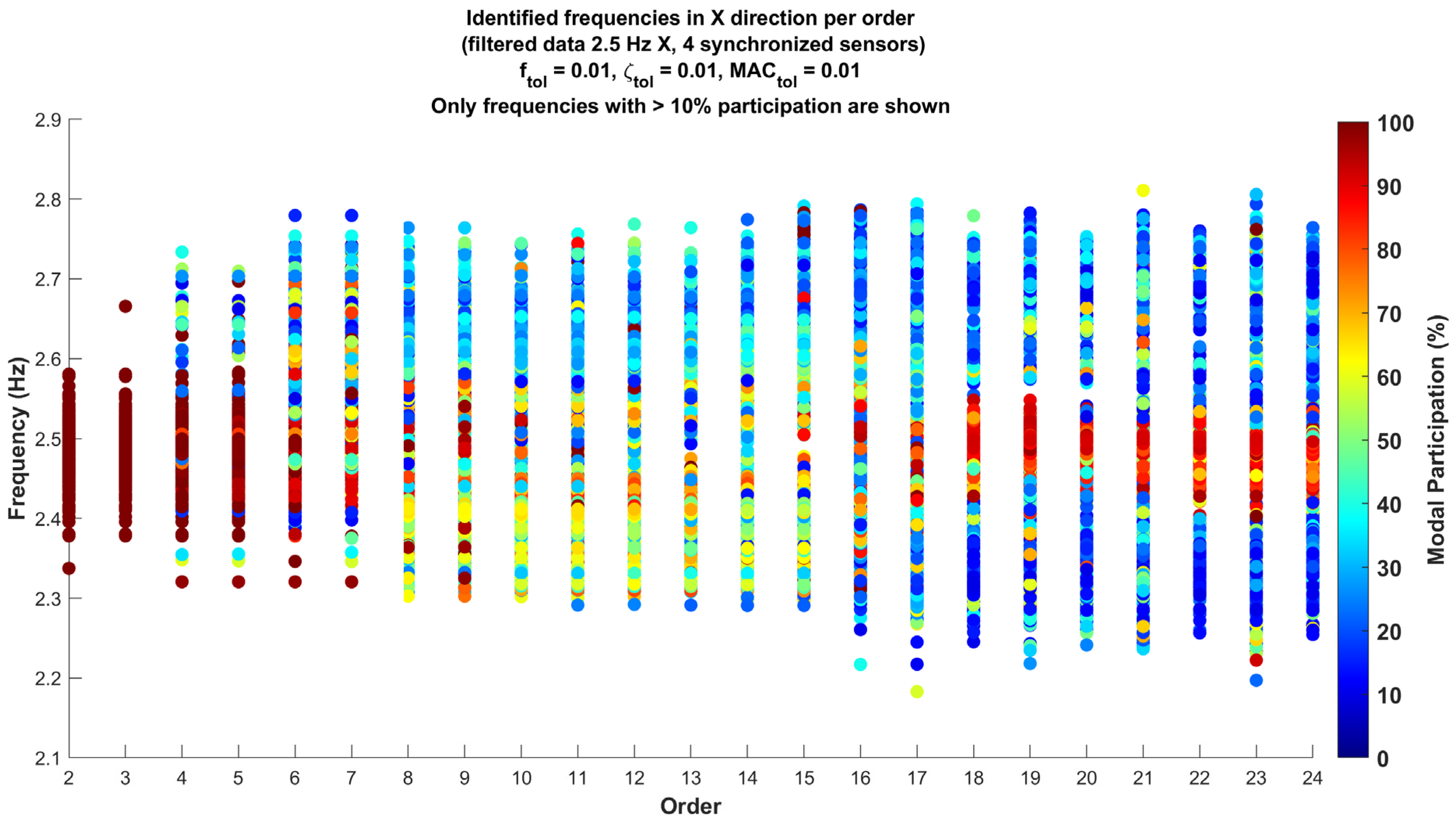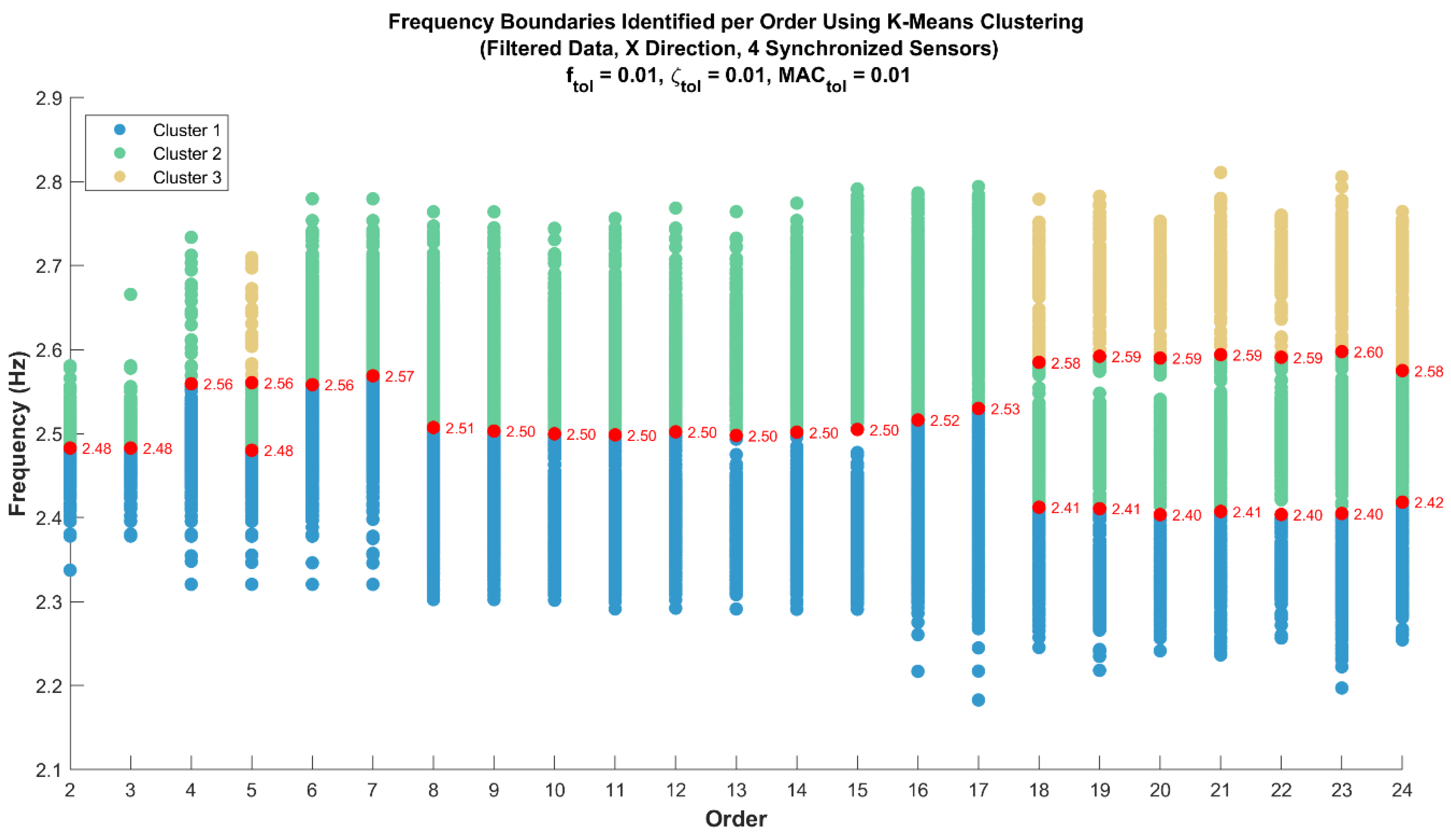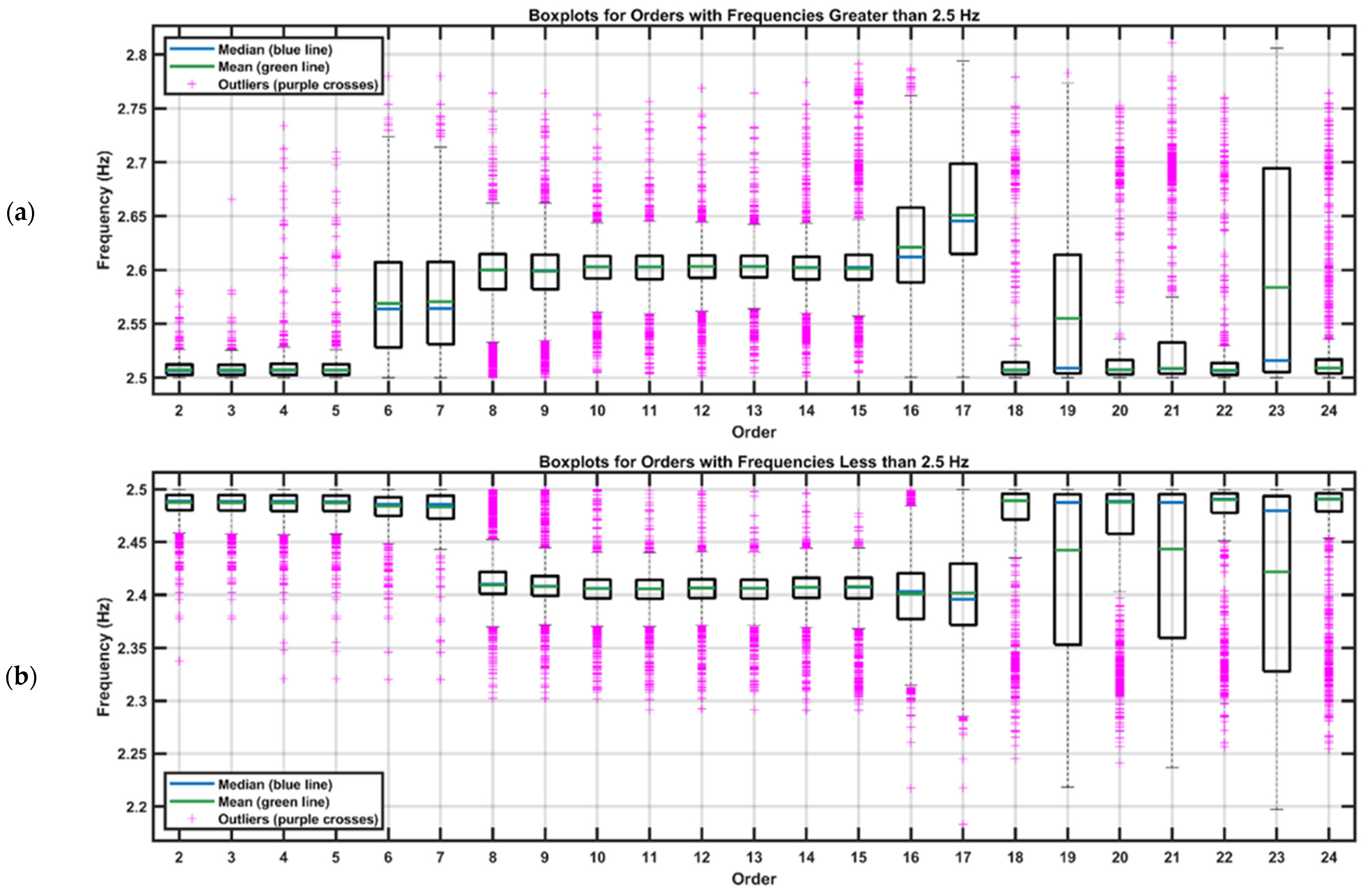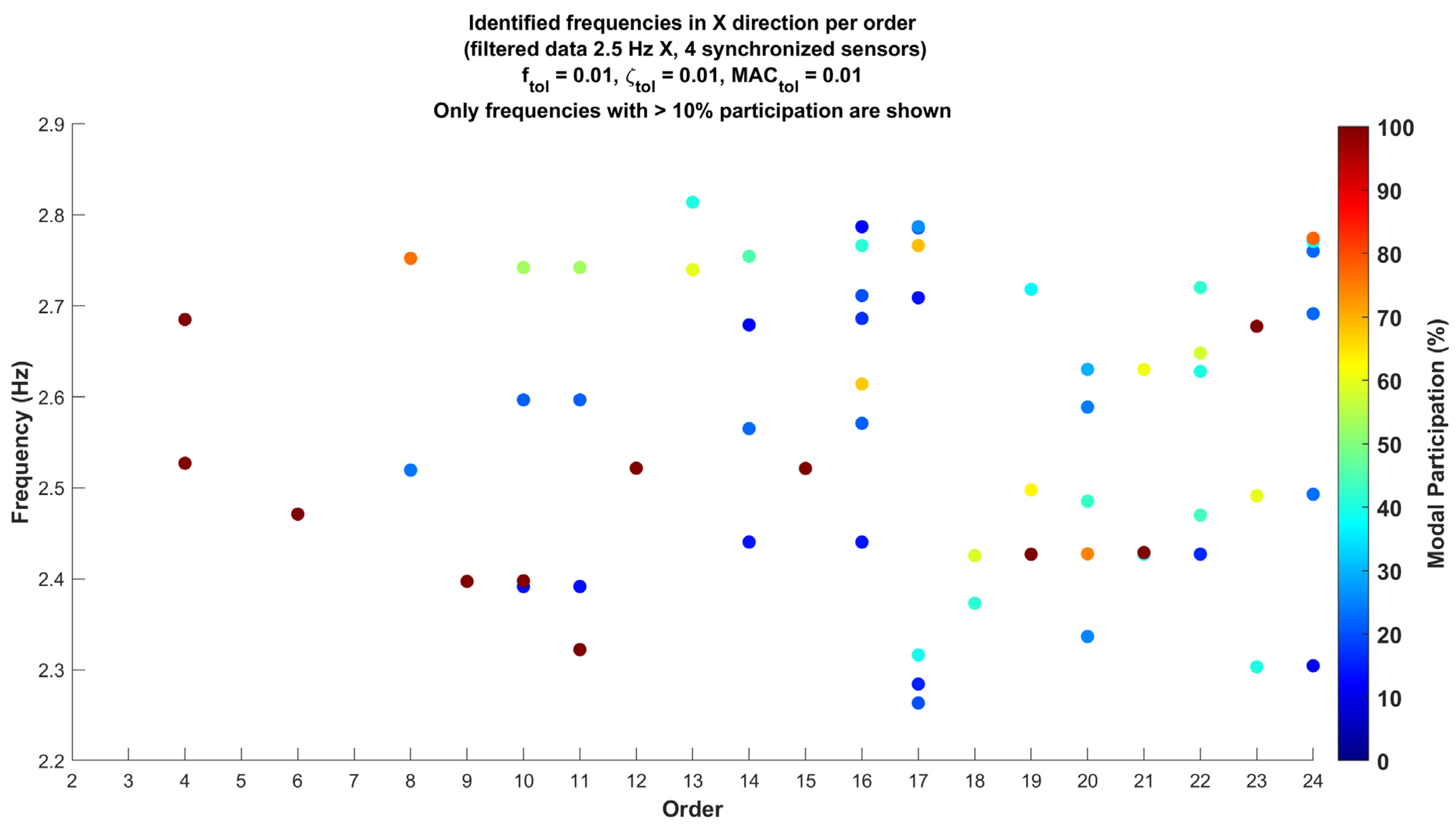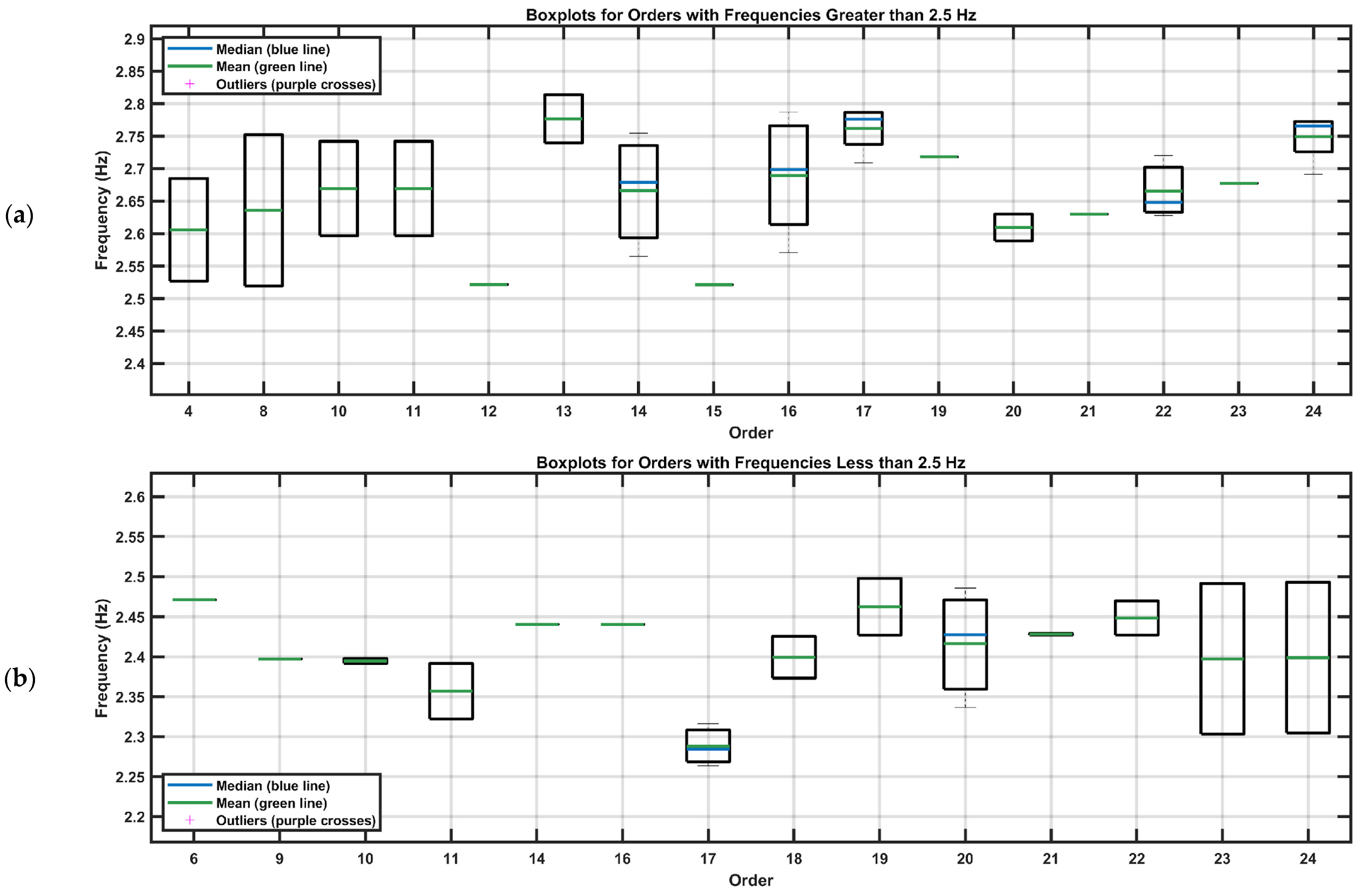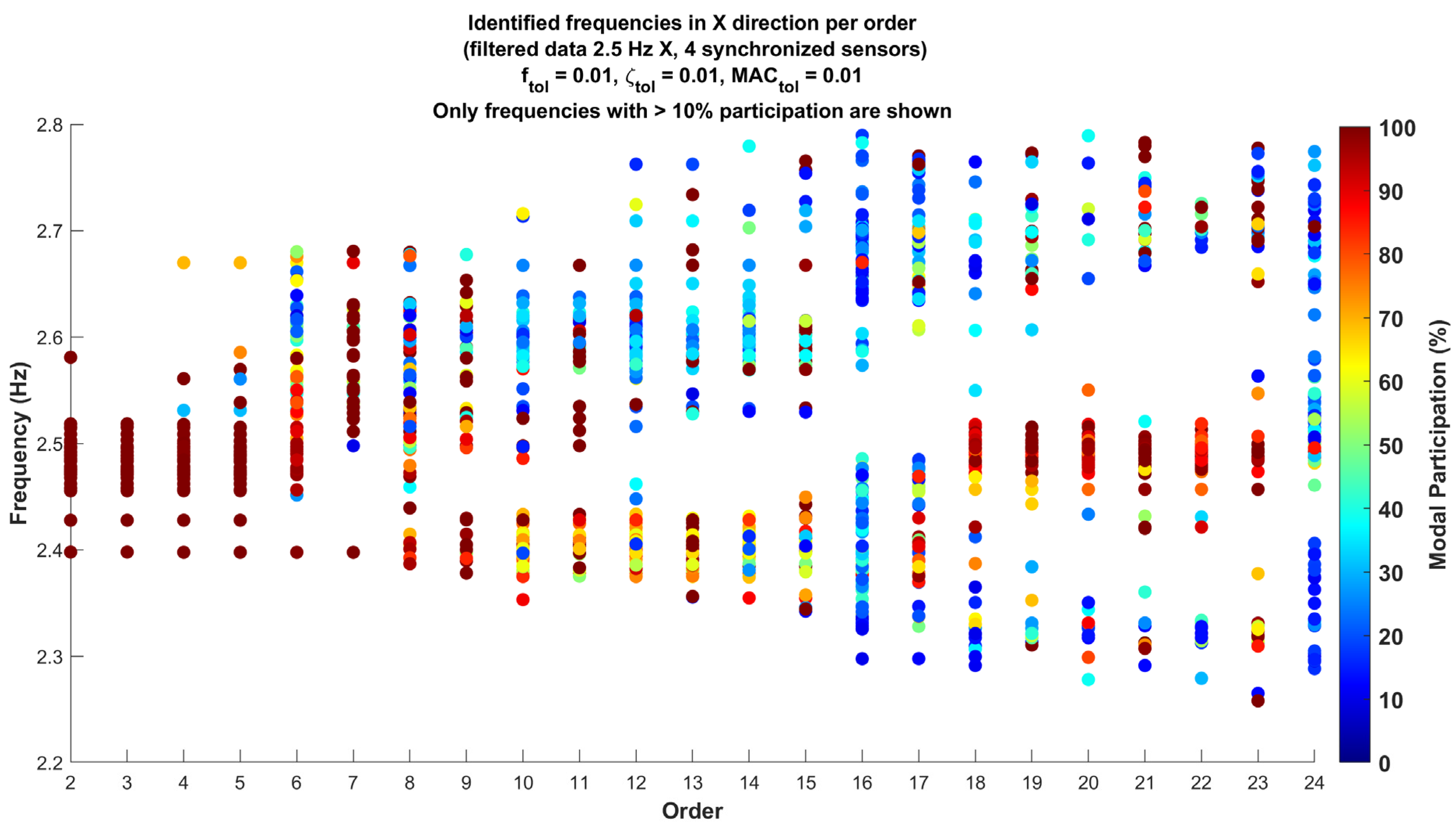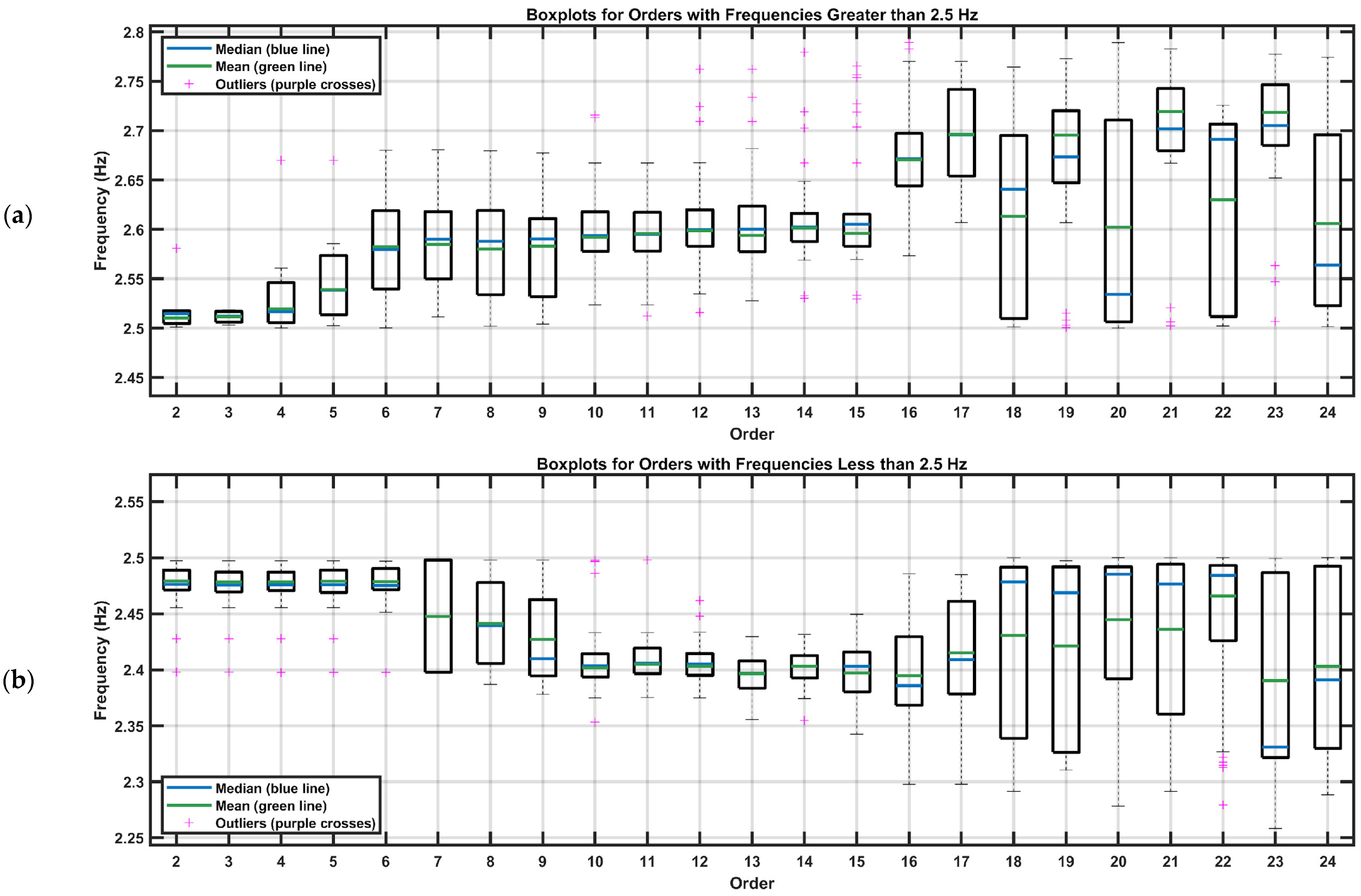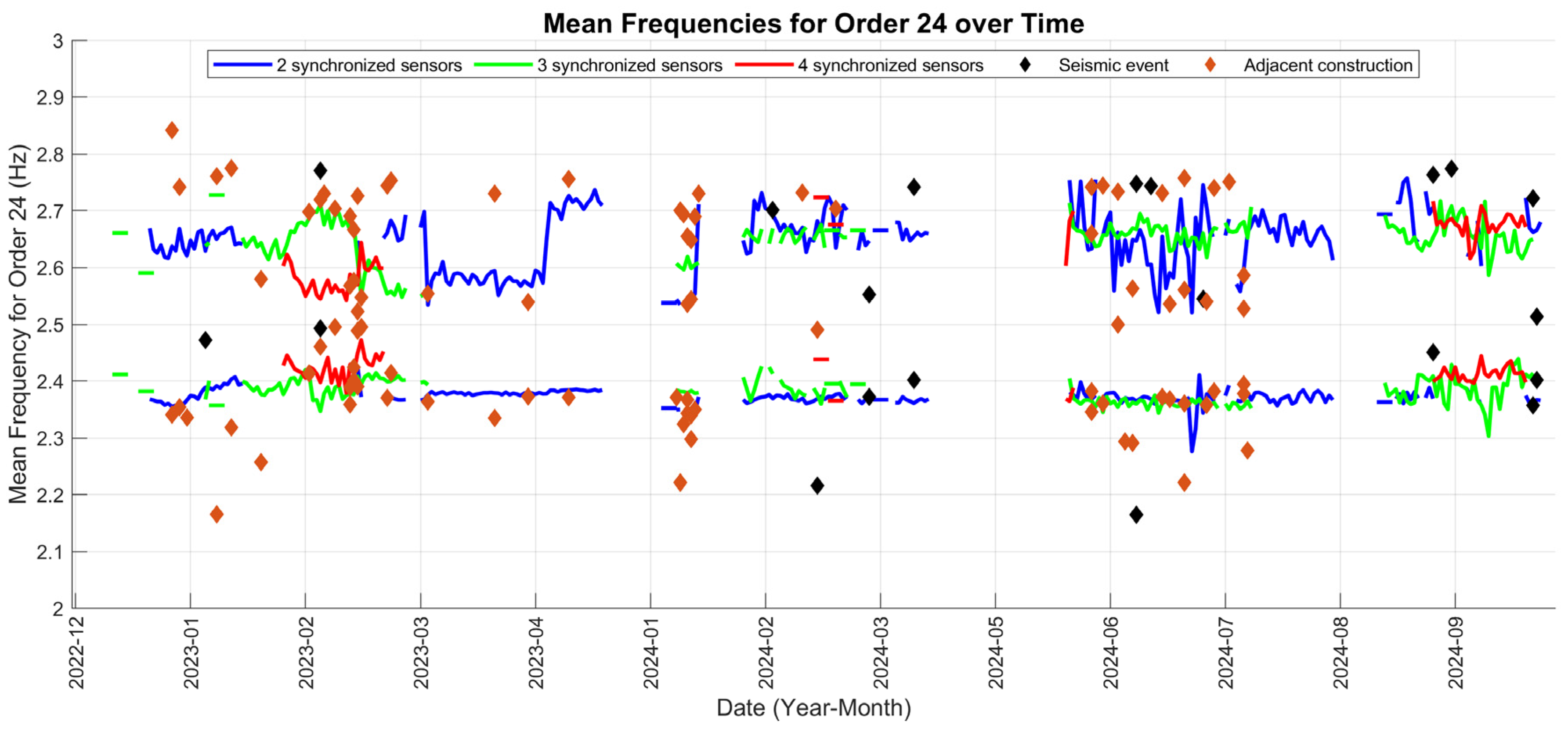The color coding in the figure distinguishes the number of synchronized sensors, with blue lines representing configurations with two synchronized sensors, green lines indicating configurations with three synchronized sensors, and red lines denoting configurations with four synchronized sensors. The continuity of each line indicates the days with complete synchronization, while the gaps reflect periods without recorded data.
Based on the synchronized data, the analysis is conducted to characterize the building’s dynamic responses under different loading conditions, including ambient vibrations, seismic events, and vibrations induced by adjacent construction. For each case, stable frequencies are identified using the SSI-COV method, and their modal participation is evaluated through stabilization diagrams and dispersion plots. These analyses allow the observation of frequency patterns and variability across different model orders, providing information on the stability and dynamic characteristics of the structure.
5.1. Ambient Vibration Results for 2022–2023
The following results correspond to the analysis of vibration data recorded during the 2022–2023 period, analyzed in 10 min intervals.
Figure 7 presents the results obtained from the analysis of the raw data with a sampling frequency of 400 Hz using the SSI-COV method. This figure shows the stable frequencies identified for each model order, ranging from order two to twenty-four, for a scenario with four synchronized sensors and for two different tolerance cases. It is important to note that these results correspond to the X direction of the building.
In both subgraphs, each point corresponds to a frequency identified at a specific model order, and the heat map color palette of the points indicates the modal participation of that frequency. It should be noted that in each individual analysis, based on 10 min segments of synchronized data, multiple stable frequencies can be found in different orders, which is essential for understanding the mode identification. The modal participation indicates how dominant or significant that frequency is in terms of its contribution to the system’s dynamics. The color range in the graph, shown in the right-side color bar, visually represents this percentage, where warmer colors (reds) indicate frequencies with higher participation, while cooler colors (blues) indicate frequencies with lower significance.
On the vertical axis, the frequency is represented in Hertz (Hz), while on the horizontal axis, the model order is shown. This representation facilitates the identification of stable modes and allows observations of how the dominant frequencies change as the model order increases. In this context, the tolerance values used play a significant role in determining stability. Specifically, two different tolerance configurations were applied. in the graph on the left, a more relaxed tolerance is applied, with the frequency tolerance set at 0.01, the damping tolerance at 0.04, and the Modal Assurance Criterion tolerance at 0.01. Meanwhile, in the graph on the right, a stricter tolerance configuration is applied, with all three tolerances (, , and ) set at 0.01.
The difference in tolerances allows an examination of the consistency of the identified frequencies. It can be observed that even with a stricter tolerance in the right graph, the resulting identified frequencies remain largely consistent with those in the left graph. This suggests that the stricter tolerance values chosen did not significantly alter the identification of dominant frequencies, implying a robust and stable system response, regardless of the applied tolerances. Analyzing different tolerance cases helps confirm the stability of the identified modes and reduces uncertainties in the results. This also suggests that the initial tolerance configuration might already be sufficiently strict for this analysis.
This observation reinforces the idea that a 400 Hz sampling frequency may be excessive for the type of analysis being conducted, as it introduces high-frequency components that do not provide valuable information about the structural dynamics. This aligns with the notion that a lower sampling frequency might be more suitable, focusing on capturing the dominant modes within a lower frequency range where the actual natural frequencies of the structure are expected to reside. In essence, the presence of high-frequency data that do not correspond to relevant modes suggests that the sampling rate may be unnecessarily high, resulting in the inclusion of extraneous high-frequency information. Therefore, a reduction in the sampling frequency to 30 Hz could be more appropriate for capturing the significant dynamic behavior of the structure, while also requiring less processing.
Next, the results of ambient vibration recordings for the 2022–2023 period are presented after applying downsampling to 30 Hz. This step was carried out with the aim of reducing the frequency range analyzed and focusing on the frequencies that are more relevant to the structural dynamics. Unlike the previous analysis of the raw data, this time, both the X and Y directions of the building were considered to observe possible variations in the identified frequencies along both directions.
Figure 8 presents the results of the downsampling data analysis for both the X and Y directions, considering the two frequencies with the highest modal participation, provided they have a participation percentage greater than 10%. The figure on the left corresponds to the frequencies identified in the X direction, while the figure on the right shows the frequencies identified in the Y direction. In both figures, the tolerance parameters used were a frequency tolerance (
) of 0.01, damping tolerance (
) of 0.01, and MAC tolerance (
l) of 0.01.
By focusing on the frequencies with the highest modal participation, the analysis seeks to reduce noise and less relevant information, facilitating the identification of patterns in the dynamic behavior of the structure. The selection of the two main frequencies is based on their relevance in terms of modal participation, as they typically reflect the most representative vibrational characteristics of the system.
There is a clear accumulation of frequencies around the value of 2.5 Hz in both directions (X and Y). This concentration indicates the presence of a dominant mode at this frequency, suggesting that this mode is consistent and significant in both directions. The persistence of this mode across different orders reinforces its importance in the building’s structural dynamics.
Another notable point is the clustering of frequencies around 10 Hz, especially in the Y direction, where this concentration seems more pronounced. This could imply the existence of a second important natural mode at this frequency, related to the vibration modes that significantly contribute to the structure’s dynamic response.
Although similarities in frequency concentrations are observed in both graphs, there are also some notable differences. For example, in the Y direction, frequencies higher than 10 Hz show greater dispersion compared to the X direction, where the concentration is denser.
In the frequency range shown (up to 15 Hz), there is a higher concentration of points at lower frequencies, indicating the relevance of these frequencies in the structural dynamics. As the frequency increases, the point density decreases and dispersion increases, especially above approximately 13 Hz, suggesting that lower frequencies are usually more representative of the natural vibration modes in structures of this type.
In summary, the analysis reveals two dominant frequency ranges around 2.5 Hz and 10 Hz that are common in both directions, indicating relevant modes for the structure. The difference in dispersion between the two directions and the lack of concentration at higher frequencies highlight the importance of these dominant modes, while higher frequencies seem to be less significant for the structural dynamics.
Based on these initial results, the analysis was centered on the identified frequency range around 2.5 Hz. A band-pass filter was applied to the original data sampled at 400 Hz, specifically targeting this frequency of interest. In
Figure 9 the analysis focused on 2.5 Hz is presented, considering the two frequencies with the highest participation per analysis and those with a participation factor greater than 10%. This approach allows for a more detailed and precise study of the predominant components in the structure, aligned with the previously described methodology.
The graph in
Figure 9 shows how the increase in the model order leads to greater dispersion of the data, indicating that as the complexity of the model increases, additional frequencies are identified that are not evident in lower orders. This phenomenon is expected, as higher orders in the SSI-COV method allow for the capture of a greater number of potential modes, although some of these may not be relevant to the analyzed structure.
In higher orders, there appears to be a concentration of frequencies in two ranges, one around 2.4 to 2.5 Hz and another around 2.7 to 2.8 Hz. Specifically, in orders 18, 19, 20, and 21, a prominent band of points can be observed around 2.5 Hz, while in orders 15 and 19, there is an accumulation of points with higher participation in the 2.7 Hz frequency range. This distribution suggests the possible presence of two relevant dynamic modes in these ranges, which could be associated with interactions or coupling between modes in different directions of the building. The identification of these frequencies with notable participation may indicate their importance in the structural dynamics of the building.
Given the observed dispersion, and with the aim of identifying possible boundaries between frequencies at each order, a clustering procedure using the k-means algorithm was applied. This method automatically groups the frequencies based on their proximity and participation, objectively establishing the boundaries between different groups of identified frequencies.
Figure 10 presents the results of this clustering analysis, highlighting the boundaries between frequency groups based on the different orders considered.
The presented graph shows the identified frequencies for each order using a filter centered at 2.5 Hz. The colors of the points represent the different groups formed through the k-means clustering method, while the red points indicate the boundaries between frequency groups, which were automatically identified by the algorithm. It is observed that as the model order increases, more groups are formed, suggesting that additional frequencies are being identified as the model becomes more complex.
The presence of these frequency groups within the same order reinforces the idea that there may be different dynamic modes that are coupled or have a predominant influence in the X direction of the building. The persistence of certain groups across multiple orders suggests that these modes are relevant to the structure and may be exhibiting consistent responses through the model.
This differentiation between groups could indicate a significant interaction of these modes with the structure or the manifestation of structural modes influencing different directions or components of the system.
Based on the boundaries identified through the clustering analysis, and with the purpose of analyzing the concentration of data by order, a threshold of 2.5 Hz was established for constructing boxplots for each order. This approach allows for a detailed observation of the dispersion and variability of frequencies. This threshold serves as a differentiating point between frequencies that could be associated with distinct dynamic modes or coupled influences within the structure.
The division at 2.5 Hz aims to provide a more precise approach to analyzing the behavior of frequency dispersion as the system order increases. In
Figure 11, the boxplots illustrate the variability within each order and allow for an evaluation of the potential impacts of dynamic modes that manifest below and above this established threshold. This separation is essential for interpreting how these modes may influence the overall structural behavior and for identifying possible correlations or interactions between the detected frequency groups.
The graph presented in
Figure 11 facilitates the analysis of the dispersion of identified frequencies, distinguishing two subsets based on the 2.5 Hz threshold. This separation underscores differences in the variability of frequencies across the different model orders. Frequencies exceeding 2.5 Hz exhibit greater dispersion compared to those below this threshold, suggesting the presence of dynamic modes or external factors that increase the complexity of the structural response in this range. Conversely, frequencies below 2.5 Hz display a more uniform dispersion, potentially indicating that the modes in this region are more stable or less affected by dynamic interactions.
The numerous outliers observed in both subsets highlight the presence of frequencies that deviate significantly from the average behavior. For frequencies above 2.5 Hz, the outliers are more widely dispersed and appear across a greater number of orders, supporting the hypothesis that modes in this range are more sensitive to external influences or model complexity. In contrast, frequencies below 2.5 Hz show less dispersed outliers with greater uniformity, indicating a smaller deviation of modes from their central tendencies.
As the model order increases, particularly for frequencies above 2.5 Hz, the boxplots reveal a trend toward greater dispersion. This pattern suggests that higher model orders capture additional modes or reflect more intricate structural responses due to increased model sophistication. Overall, this analysis elucidates the influence of dynamic modes across different frequency ranges and highlights how increasing the model order affects mode identification and frequency dispersion. These findings contribute to a deeper understanding of the structure’s overall behavior and aid in identifying potential correlations or interactions among the detected frequency groups.
5.2. Ambient Vibration Results for 2024
Based on the analysis of the previously obtained results, the 2024 ambient vibration study once again focuses on the frequency range around 2.5 Hz, which was identified as relevant to the structural dynamics. Using a band-pass filter applied to the original data sampled at 400 Hz, the two frequencies with the highest participation per analysis were identified, considering only those with a participation factor greater than 10% and maintaining the same tolerance for the dynamic parameters as in the previous results.
Figure 12 shows the results of the 2024 ambient vibration data, focusing on the frequency around 2.5 Hz. This analysis centers on identifying the dominant frequencies and their participation in the range of interests, using data collected from four synchronized sensors.
Continuing with the analysis, the clustering process is applied to the data to identify frequency boundaries. In
Figure 13, it can be observed how the frequencies are grouped into different categories. Consistent with the previously analyzed data, red points represent the frequency boundaries identified for each model order, enabling the observation of dominant frequency ranges and their variations as the model order increases.
When comparing the clustering results between the periods of 2022–2023 and 2024, a similar trend is observed in the stability and grouping of frequencies as the model order increases. In both analyses, the dominant frequencies in the range close to 2.5 Hz show consistency in their identification, standing out as significant modes across different orders. As the model order increases, the frequencies tend to group coherently, and the frequency boundaries, indicated in red, maintain similar values in both periods, reflecting possible stable patterns in the structural dynamics.
To analyze the concentration of data by order, boxplots were constructed while maintaining the 2.5 Hz threshold.
Figure 14 presents these charts, allowing a visualization of the dispersion and variability of frequencies in each order, with frequencies above 2.5 Hz shown at the top and frequencies below 2.5 Hz at the bottom.
It can be observed that for frequencies above 2.5 Hz, there is a greater dispersion compared to frequencies below this threshold, suggesting the existence of additional dynamic modes or the influence of factors that increase the complexity of the structural response in this region. In contrast, frequencies below 2.5 Hz show a more uniform dispersion, which could indicate that modes in this region are more stable or less susceptible to dynamic interactions.
The presence of numerous outliers in both subsets highlights the existence of frequencies that deviate significantly from the average behavior. For frequencies above 2.5 Hz, the outliers are more dispersed and observed across a larger number of orders, reinforcing the hypothesis that the modes in this region are more sensitive to external factors or model complexity. In the case of frequencies below 2.5 Hz, the outliers are less dispersed and exhibit greater uniformity, suggesting a lesser deviation of modes from their central behavior.
As the model order increases, especially for frequencies above 2.5 Hz, the boxplots show a tendency toward greater dispersion. This pattern indicates that at higher orders, additional modes are being identified, or the structure exhibits more complex responses as the model becomes more sophisticated. Overall, this analysis allows the interpretation of the influence of dynamic modes across different frequency ranges and how increasing model order can impact mode identification and the frequency dispersion. These results are essential for a better understanding of the overall behavior of the structure and identifying potential correlations or interactions between the detected frequency groups.
Comparing the 2024 results with those from 2022–2023, consistent behavior is observed in the dispersion and stability of modes across different orders and frequency ranges. Both campaigns show greater variability for frequencies above 2.5 Hz and more controlled dispersion for lower frequencies, reinforcing the reliability of the dynamic patterns identified in both analysis periods.
5.3. Seismic Event Results
To begin the analysis of seismic records, a compilation of all recorded events throughout the study was made, given that the amount of individual data is limited. With these unified data, the same analysis approach used for ambient vibrations was continued, focusing on the same frequency range previously identified. This procedure allows a coherent comparison between the dynamic modes associated with seismic events and those obtained in the ambient vibration analysis, thus enriching the understanding of the structural behavior under different conditions.
Based on this approach, the analysis of seismic records now considers all identified frequencies per analysis, focusing only on those with a participation factor greater than 10%. In
Figure 15, the graph illustrating these identified frequencies by model order can be observed.
Distinct frequency bands are observed, particularly around 2.4 Hz, 2.5 Hz, and 2.7 Hz, where higher participation factors are noted. This concentration at specific frequencies indicates that these ranges have a notable influence on the structural dynamics.
To analyze the concentration of data by order in the seismic records, boxplots were constructed using the 2.5 Hz threshold as a reference, despite the limited amount of data. This analysis seeks to provide insights into the dispersion and variability patterns for each order, maintaining consistency with the results from the ambient vibration analysis.
Figure 16 presents the chart, where frequencies above 2.5 Hz are shown at the top and frequencies below 2.5 Hz at the bottom.
For frequencies above 2.5 Hz, a greater level of data dispersion is evident. The mean values across different orders in this range are higher than those observed in the ambient vibration records, potentially due to the smaller dataset available for the seismic analysis compared to the ambient vibration analysis. This increased dispersion may indicate that the structure exhibits greater variability in its dynamic response within this frequency range.
In contrast, frequencies below 2.5 Hz display more uniform and stable dispersion, suggesting that the modes in this range are more consistent and less affected by dynamic interactions. Within this range, the frequency of 2.4 Hz emerges as a notable and stable value in the structure. This frequency holds particular relevance, as it is consistently identified in both seismic records and ambient vibration analyses, reinforcing its importance in the structure’s dynamic behavior.
5.4. Adjacent Construction Activity Results
For the analysis of vibration records generated by adjacent construction activity, the same procedure previously applied to ambient vibrations and seismic records was followed.
A representative dataset of vibrations generated by construction activity was compiled. These data were processed using the same frequency selection criteria, focusing on those with participation factors above 10%.
Figure 17 shows the identified frequencies by mode order in the system, allowing for the observation of relevant frequency bands in the records associated with this specific activity.
The graph in
Figure 17 highlights several frequency concentrations, particularly around 2.4 Hz, 2.5 Hz, and 2.7 Hz. These concentrations suggest that these specific frequencies are of notable relevance, as they consistently appeared in previous analyses of ambient vibrations and seismic activity.
To examine the concentration of data by order in the construction records, boxplots were generated while maintaining the 2.5 Hz threshold, consistent with prior analyses. This representation provides a visual interpretation of dispersion and variability patterns across orders, ensuring alignment with the results from ambient vibration and seismic analyses.
Figure 18 shows the boxplots, with frequencies above 2.5 Hz at the top and frequencies below 2.5 Hz at the bottom.
The boxplots for frequencies above 2.5 Hz reveal significant data dispersion, which may indicate greater variability in the system’s dynamic response within this frequency range under construction vibrations. In contrast, frequencies below 2.5 Hz display a more uniform and stable dispersion, suggesting greater consistency and reduced susceptibility to dynamic interactions in this range.
The frequency around 2.4 Hz emerges as a notable and stable component of the structure, consistently appearing in the results of ambient, seismic, and construction vibration analyses. This consistency underscores the relevance of this frequency in the dynamic behavior of the structure.
To analyze the time-dependent behavior of the system’s dynamic response,
Figure 19 presents a specific study of the frequencies of order 24, filtered in relation to 2.5 Hz, both below and above this threshold. For this visualization, all frequencies of this order were extracted in 10 min intervals, maintaining the previous analyses of the range below 2.5 Hz and adding an additional analysis of the higher range. In each analysis, the frequency with the highest participation within each interval was selected. Then, the daily mean of these maximum frequencies was calculated to observe its evolution over time.
The main objective of this graph is to monitor the consistency and behavior of these specific frequency ranges over time under different sensor synchronization configurations. Independent analyses were conducted using two, three, and four synchronized sensors to evaluate how the mean of these frequencies varies based on the number of sensors used. This comparison helps to understand whether the number of sensors influences the stability or variability of the analyzed frequencies and how they respond to different dynamic conditions over time.
Additionally, diamond-shaped markers were included in the graph to represent seismic events and adjacent construction activities impacting the analyzed frequencies. This allows us to visualize whether these external events have any notable impact on the stability or variability of the frequencies. By analyzing these results, we can assess whether the frequencies in the observed ranges show consistent behavior, which could indicate structural stability, or if they exhibit variations that may signal the influence of external factors or the inherent dynamic response of the system.

